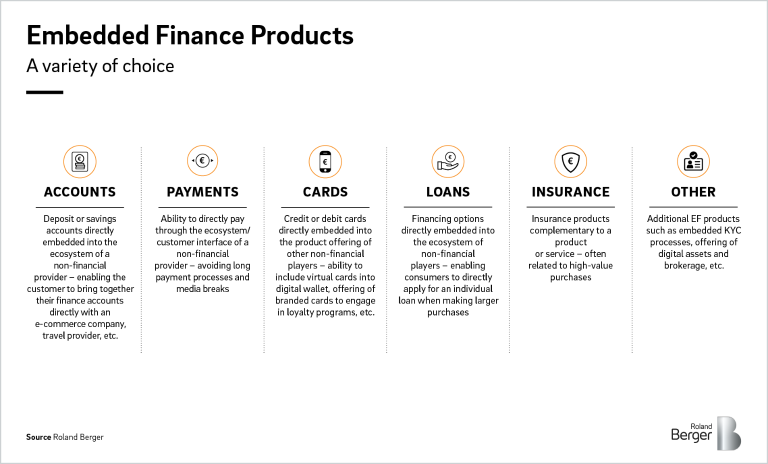Tokenisation has the potential to become the backbone of Europe’s economy in an even more digital world. It will be a key driver for change in many areas like the industry by merging supply chains, finance and logistics into a single seamless process, the financial sector by allowing new forms of financing, asset allocation and processing, the private life as well as the public sector.


Embedded finance: Disrupting the value chain for financial services
How to enhance your business and drive revenue growth
From improved conversion rates to new revenue streams – embedding financial services directly into customer journeys can benefit businesses in various ways. The concept isn't new – co-branded payment cards have been around for decades. However, rising consumer demand for efficient payment options is now combining with growth in embedded finance solutions available to corporates. In a new study, Roland Berger, in collaboration with Solaris , explores the potential benefits of embedded finance for businesses in many sectors, as well as analyzing the views and experiences of both consumers and corporates.

Embedded finance integrates financial offerings into non-financial products and services, making them more accessible and convenient for consumers and businesses. Examples include payment options like PayPal or Klarna integrated into e-commerce platforms, or insurance options within travel booking platforms. This breaks up and modularizes the traditional banking value chain, enabling non-financial services to offer financial services to their customers right where they need them.
The embedded finance market can be broken down into three main segments:
- Regulated entities that create the products, such as banks, payment specialists, consumer finance players, fintechs, and insurance companies.
- Distributors that bring the product to market, including retailers, OEMs, telecommunications firms, real estate companies and fintechs.
- Users that utilize the product, such as retail or business customers.
There is a huge variety of products available, from savings and payment options to loans insurance services.
Gaining a clearer picture of embedded finance
Today, the embedded finance market is estimated at just over EUR 55 billion, but by 2028 it could grow to EUR 180 billion due to a variety of factors, including revenue developments, increased digitalization and growth in consumer and SME lending. The market has huge potential for all relevant stakeholders. For non-financial services companies in particular, it can boost conversion and retention rates, increase average basket value, and generate additional revenue streams.
But while more and more businesses are starting to tap into these advantages – from Lufthansa to Apple and Shopify – the embedded finance market is yet to fully take off. There are several reasons for this, including the pace of digitalization within the finance sector, regulation, and a lack of standard application programming interfaces.
To obtain a more complete picture of the market, Roland Berger, in partnership with Solaris, surveyed both consumers and leading corporate executives across Europe. The aim was to learn more about motivations, satisfaction levels and expectations around embedded finance, as well as gauging consumer and corporate adoption of existing products and services.
Understanding the consumer perspective
There are numerous benefits for consumers, from greater convenience to new product offerings and more personalized offers.
"By embedding financial services, companies can provide a seamless experience for their customers, rather than forcing them to go to another provider or redirect."
However, our study shows the embedded finance sector still has work to do to raise trust and awareness levels among consumers. Several of the most important findings are highlighted below. More detailed results are available in the full report, which can be downloaded at the end of this article.
Many consumers are already regular users of embedded finance in the form of branded credit and debit cards, and digital wallets. They require a high level of trust in any non-financial company before using an embedded finance product, and are unwilling to pay a premium for it. Already on the rise, demand for savings accounts and insurance products is set to grow further, alongside established products.
How can embedded finance benefit your company?
Embedded finance also offers considerable advantages for companies from a variety of sectors, many of which can boost revenues.
Fewer redirects and interruptions make for a smoother, faster and more error-free transaction process, which can produce higher conversion rates. This same smooth process can benefit customer retention. Daily interaction through payments helps to keep a brand top of mind as well as enhance trust. Embedded finance can also yield important data for both producers and distributors of embedded finance products, offering greater insight into customer spending habits.
According to the executives we spoke with, corporate adoption of embedded finance is growing across various industries, but it won’t all be plain sailing. Key challenges include legal issues, regulatory compliance, customer adoption and trust.
Four key factors for success
Based on our research and extensive experience in implementing embedded finance solutions across many industries, we have identified four key factors for integrating embedded finance products and services.
- Provide a seamless product experience
Embedded finance products should be seamlessly integrated into the customer journey without any media breaks and where convenience for the user is the main priority. Customer convenience is what ultimately drives conversion. - Ensure a scalable product offering
The embedded finance offering should be scalable in terms of product range and number of customers for different regions. Technologically advanced companies may be able to ensure such flexibility to quickly react to changing customer preferences. - Establish trust
Customers need to have confidence in the security and reliability of both the non-financial corporate and the bank product provider. Trust can be established by demonstrating financial stability and providing transparency about terms and conditions as well as pricing. - Pricing
Pricing should not create any friction in the customer journey. The embedded finance offering can be priced competitively for consumers, ensuring however that the embedded product is not priced higher than a non-embedded product.
To learn more about the results of our survey, and to see our seven steps on how to successfully implement an EF solution, please download the full report below.
Register now to download the complete study and receive regular updates and information.


_image_caption_none.png)








_person_144.png)

